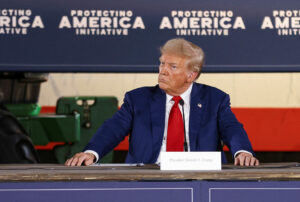By Justine Irish D. Tabile, Reporter
THE PHILIPPINES will need to diversify its export markets, strengthen its supply chains, and graduate to higher-value industries to tap opportunities that can opened up with the new tariff policies to be imposed by US President Donald J. Trump.
Former Trade Undersecretary Rafaelita M. Aldaba said that the Philippines needs to reduce its reliance on exporting to the US by expanding trade with ASEAN and deepening partnerships with Japan and the European Union.
“We also need to strengthen, of course, our supply chain resilience, reducing dependence on China and exploring sourcing from Vietnam, Indonesia, India, and other countries,” she said at an online panel discussion organized by the Philippine Manufacturing Team on Friday.
She also said that the Philippines should leverage the Regional Comprehensive Economic Partnership, the EU Generalized Scheme of Preferences, and the ASEAN FTA to access lower tariffs and wider markets.
“We need to invest in higher-value industries and move beyond low-cost production, and we need to closely monitor trade policy. We need to stay updated on US trade policies and tariff changes to adjust our strategies accordingly,” she added.
She said that studies on the likely impact of a tariff war between the US and China indicate that some regional neighbors will successfully substitute for targeted Chinese goods.
“The largest export winners were Vietnam, Thailand, Korea, and Mexico,” she added.
She said other bystander countries were able to early on identify the trade war as an opportunity, and invested in new plants, trade infrastructure, and trade facilitation.
Citing a report by the IMF’s Asia and Pacific Department, she said that the Philippine industrial performance is being held down by ease of doing business and high barriers to foreign direct investment and international trade.
“The Philippine share of the global export market and export diversification lagged behind other ASEAN countries. And the Philippines’ participation in global value chains has also declined over time, and is below many ASEAN peers,” she said.
She said industries need more support from the government in the face of such uncertainty.
“The government has a huge role to play in leveraging trade agreements, investing in higher-value industries, and embracing digitalization and innovation,” she said.
“I think these measures are all necessary to equip and empower our businesses and enable them to better navigate trade uncertainties and remain competitive,” she added.
Philippine Economic Zone Authority Director General Tereso O. Panga said that Mr. Trump’s new trade policy presents an opportunity for the Philippines to attract companies that might be relocating out of China as that market becomes less competitive because of tariffs.
“We’re seeing this happening already. In fact, we’ve been registering projects where companies from the electronics and automotive sectors are relocating because of the need to service the requirements of the US market. This could be a windfall for the Philippines,” Mr. Panga said.
“I would say the biggest winners could be from those in the electronics sector,” he added.
However, he said the Philippines will need to step up and upgrade its capabilities to benefit from this “pivot” by manufacturers.
Philippine Parts Makers Association President Ferdinand I. Raquelsantos said the revival of the US Generalized System of Preferences (GSP) could make the Philippines a good prospect for manufacturers that are relocating.
“Hopefully the government can revive the GSP that we used to have with the US. With that, we will be able to get access and be able to export our products a lot easier,” he said.
He said that when the US GSP was in force before the pandemic, a lot of manufacturers were able to export automotive parts.
“Unfortunately, when the GSP lapsed (in 2020), we had problems,” he said.
The Philippines was a beneficiary of the US GSP, which eliminated duties on approximately 5,000, or 47%, of all tariff lines.
Eligibility for the US GSP benefits expired on Dec. 31, 2020, which caused Philippine exports to the US that were previously duty-free under the preferential scheme to be subject to most-favored-nation tariffs.
While active, the Philippines was the fifth-largest beneficiary of the US GSP with about $1.6 billion in duty-free exports in 2020. This accounted for 10% of US GSP imports.
